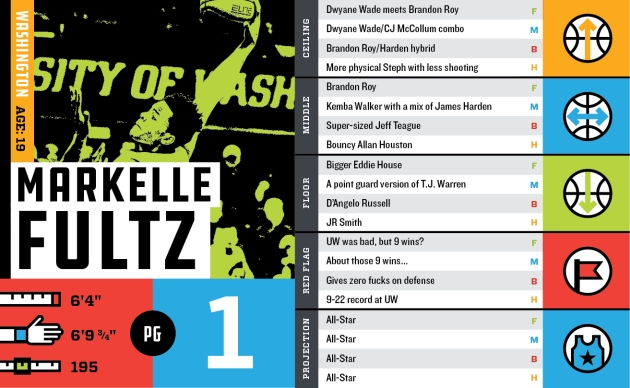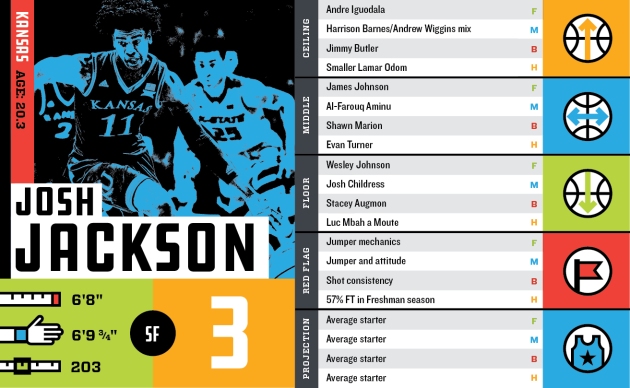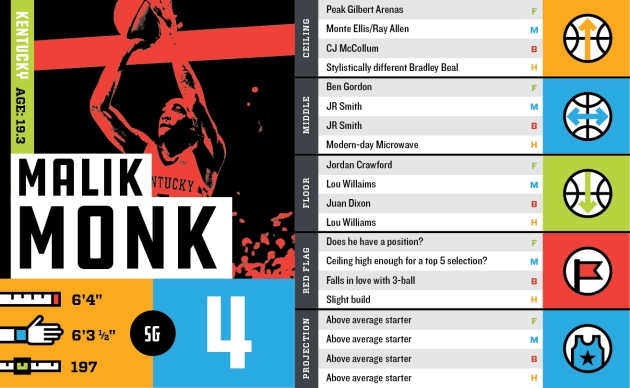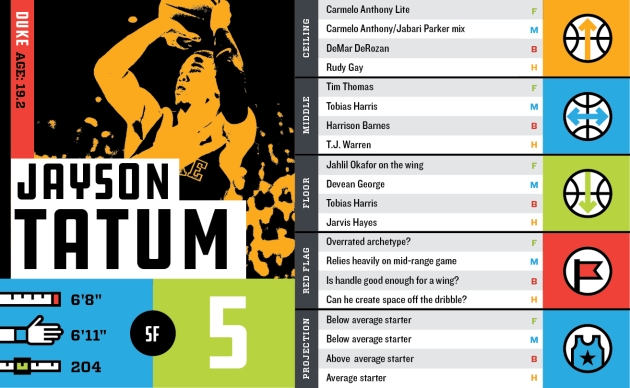Bug: I’m a believer in the theory the great Isiah Thomas put forth in Bill Simmons’s Book of Basketball, “the secret to basketball is that it’s not about basketball.” The secret to Lonzo Ball’s game is not about the stats, it’s about being a floor general that puts his team in the best position to be successful. Zo doesn’t have stats that jump off the page, but his presence on the court instantly transformed a floundering UCLA program into an offensive juggernaut. It’s easy to get lost in the buffoonery of his father, Lavar Ball, but the talent of the kid is undeniable. Yes, he has an ugly shot, but if it goes in (41% from 3 on 194 attempts at UCLA), who cares? Everyone immediately thinks of Jason Kidd when watching Lonzo: big guard, great decision making, makes everyone around him better. In addition to the Kidd-like qualities, Zo can also go up and finish above the rim with ease. There is much debate about who should be the #1 pick in this year’s draft, but for me, I’m taking the point guard with the infectious style of play that uplifts an entire team. It’s not just about basketball, this kid will impact the entire culture of the organization that drafts him.
Bug: With the way the NBA is evolving to a smaller, up-tempo game, Josh Jackson seems to be a perfect for today’s game. When you watch him play, the thing that stands out is the variety of ways he can impact the game. He is able to do a bit of everything on the court, both offensively and defensively. The way Kansas used him ranged from post ups to slashing to running the break and giving the ball up to teammates for easy finishes. Mr. Jackson also shot a respectable 37.8% from 3 during his freshman season on one of best teams in the nation. While his offensive game has a good foundation and room for growth, the thing that has many scounts salivating is the equally tantilizing potential on defense. The kid flat out gets after it on the defensive end (1.7 spg & over a block a game), while also possessing the ability to guard 2-3 positions. The lackluster FT shooting (57% at KU) and unconventional shot mechanics could hold him back early in his career, but his impact in other facets of the game will get him a fair share of floor time as a rookie. Versatility is the name of the game for the modern NBA wing, and Jackson has it in spades.
Hamilton: Playing on national TV twice-a-week made it easy to catch Malik Monk in action. There was plenty to watch too. On a typically loaded team Monk routinely stood out. His incendiary offensive outbursts were certainly attention-grabbing (30 pts in 2nd half points vs Florida; 47 vs UNC on 16-28 FG). This wasn’t lost on many folks as he was named 1st team All-SEC. He plays with a sense of timing and understands when his team needs the offensive lift he’s always happy to provide. While his measurements aren’t great for a SG (6’3, 6’6 wingspan) he makes up for it with a quick release and legit NBA leaping ability. The release on his shot is consistent while the rotation and arc of the ball give most of his attempts a chance. This is evident in his 40% from 3 on 8 attempts per game. As most modern small-ish guards, he showed nice touch on his floater and uses a quick deciesive first step to get to the paint and get it off. Looks to get all the way to the rim for the dunk when he can do it off one or two dribbles. Whether he can do that against NBA defense with his slighter build remains to be seen. That quick first step from a standstill allows him to create space for pull up jump shots off the dribble. As most right-handed players, he’s more comfortable going to his left when shooting, but he’s very capable pulling up going right. He showed the range to shoot off the bounce from deep and should be able to eventually be a very reliable NBA 3 point shooter. Has a decent amount of what I like to call slickness. Slickness is a spectrum with Harry Barnes on the low end, while Jamal Crawford is the slickest. Monk leans toward JC at this point, which is a good thing. This is an area I would expect him to spend significant time on by developing more compex dribble moves and attacking tight gaps going toward the basket … Doesn’t strike me as much of a combo guard at this point, and I have my doubts he ever will be one. He’s far more comfortable coming off screens or attacking off a catch than running high pick and roll or finding open guys on his drive. WIth a great shot and relentlessness on the attack, Monk should be a good pro. How good may be very situational. Playing alongside the right PG may matter, which isn’t necessarily a knock on him. In other words, I’m not sure how he’d fair in Philly during the Ben Simmons PG experiment. But a John Wall or Mike Conley type would set Monk up nicely (to be fair those guys would set me up nicely). He seems to really enjoy playing baskebtall and competing, which will serve him well in development. It may take a couple years for Monk to figure out how to use his skills effectively in the NBA but I suspect he will do that and have a nice career.
Fenrich: I have so much confusion about Jayson Tatum. He has a ton of offensive skill and a game that’s well-developed beyond his 19 years. He’s comfortable in the post with a turn-and-face game and pretty much dogged out college defenders there. His range extends out to NBA three-point distances, even if the consistency isn’t there yet — he shot just 34% from deep on four attempts-per-game. The mechanics on his jumper look good and his form doesn’t breakdown much. Tatum looks the part of an NBA wing with his size, length, and athleticism. And maybe that’s part of the problem. His game reminds one almost immediately of Rudy Gay though Gay’s longer (7’3″ vs. 6’11” wingspan) with more bounce. There are hints of a Carmelo Anthony-type attacker which is seen in that post and face-up game. Tatum doesn’t have nearly the strength of a young Melo, but the refinement is there. JZ Mazlish of Wingspan Addicts did a great job of identifying the crux of the Tatum conundrum of the problem with scouting Tatum. It is a break in the value placed by traditional scouting approaches against the progressive approach of a numbers/analytics based community. If Tatum spent a decent chunk of his time at Duke playing power forward where he was able to abuse slower defenders, it doesn’t appear something that will translate against NBA fours. So if he’s a natural three, can he guard starting wings on a nightly basis or even score against them? At a first glance, the answer seems to be no. He looks like he’ll be better-suited as a rotation forward who can play the four in some small ball lineups. The skill is there, but the ceiling looks low and if I re-did my big board rankings, he’d likely drop down a bit. For some reason, the more I see and think about him, the more he becomes the wing version of fellow Dukie, Jahlil Okafor — a talented offensive player who probably would’ve been better-suited for the NBA of the 1990s.






Pingback: NBA Draft Big Board | Players 6-10 | Dancing With Noah
Pingback: NBA Draft Big Board | Players 11-15 | Dancing With Noah